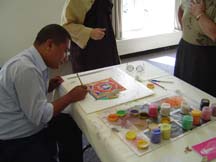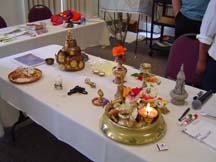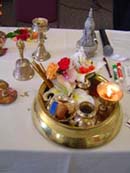Lisa Faden
Newton North High School, Newton, MA
Tibet in an Asian Studies Curriculum
Geography

(Image courtesy of www.himalayanart.org)
Himalayan Buddhism
A very helpful perpective on teaching about Buddhism in the American classroom is provided by Todd Lewis in his essay, "Representations of Buddhism in Undergraduate Teaching: The Centrality of Ritual and Story Narratives," collected in Victor Hori, et al eds. Teaching Buddhism in the West (London: RougledgeCurzon, 2002). Professor Lewis observes that American teachers tend to introduce Buddhist thought through its important doctrines, such as the Four Noble Truths and the Eightfold Path. He argues that this focus on abstract teachings does not paint a representative picture of the religion as it is practiced by a majority of Buddhists because only monastics (monks and nuns) can fully devote their lives to the teachings of the Buddha.
In reality the majority of Buddhists are lay people, also known as householders. They are an essential part of the Buddhist community because they demonstrate their devotion by participating in rituals and by giving donations to monasteries. Thus they gain merit and move towards a more fortunate rebirth in the next life. Teaching about Buddhism, therefore, should combine philosophy with the actual practice of Buddhist monastics and lay people.
Professor Lewis's argument fits in well with my own interest in teaching about religion through art and iconography. Below are several sources for taking arts-based approach to teaching about Buddhism.
Resources for Teaching about Buddhism
A starting point for teaching about Buddhism is the life of the Buddha. There are many versions of the story available in print, illustrated, comic book, and video form. I like to use the 1993 Bernardo Bertolucci film Little Buddha. I show just the excerpts of the film that tell the story of the Buddha's life, from his birth through his enlightenment. I like to use the movie because the colors are lush, and the director has taken care to tell the story as it is told in traditional Buddhist literature.
Other important stories from the Buddhist tradition are the Jataka Tales, which tell of the previous incarnations of the Buddha. They teach morality by providing models for compassionate behavior in a variety of contexts. There are also many interesting stories about how the Buddha spread his teachings and established the Buddhist community after his enlightenment.
From the life of the Buddha, students are ready to move on to explore Buddhist art, which shows how Buddha's life and teaching are represented in a variety of cultures. The Freer and Sackler Galleries of the Smithsonian Institute have an excellent curriculum, The Art of Buddhism, which you can download for free. It is 136 pages and includes maps, illustrations, lesson plans, and essays on Buddhism in India, China and Japan. They also have a shorter article in their publication Connections, The Himalayas: An Aesthetic Advanture.
The Asia Society's Exploring the Mandala provides clear images and explanations of Buddhist iconography. I particularly like the "looking exercise" that they have as a warm-up to having students interpreting Buddhist images. It is very practical and usable for the classroom.
Himalayan and Tibetan art is known for its bright colors and vivid images. For art specific to Tibetan Buddhist iconography, the Shelley and Donald Rubin Foundation's Himalayan Art site is an online gallery of over 17,000 images a search engine that makes it easy to find different kinds of images. Two print sources for information on Tibetan Buddhist art are Robert E. Fisher's The Art of Tibet (London: Thames and Hudson, 1997) and David and Janice Jackson's Tibetan Thangka Painting: Methods and Materials, 2nd edition (Ithaca, NY: Snow Lion Press, 1988).
An especially beautiful and delicate art form is the Tibetan sand mandala. In 1998 the Washington Post chronicled the creation of a large sand mandala at the Sackler Gallery. You can see the process of constructing the sand mandala and read about its symbolism in the Washington Post photogallery.
On August 4, 2004, Naresh Bajracarya came to Holy Cross to create a sand mandala and to speak about Mahayana Ritualism and the Mandala to the participants in the Cultures and Religions of the Himalayan Region Institute. Dr. Bajracarya is the head of the Central Department of Buddhist Studies at Tribhuvan University in Nepal. His handout, "The Guru-mandala Arcana," on mandala and Puja is a helpful explanation of Buddhist ritual and is posted here with his permission, accompanied by photographs from his presentation.
"The Guru-mandala-Arcana" by Dr. Naresh Bajracarya
This site was created by Lisa Faden at the NEH Summer Institute "Cultures and Religions of the Himalayan Region," held at the College of the Holy Cross, Summer 2004




